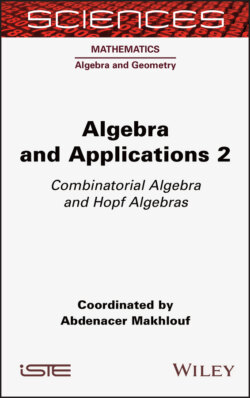Читать книгу Algebra and Applications 2 - Группа авторов - Страница 5
Оглавление
Preface
Abdenacer MAKHLOUF
University of Haute Alsace, Mulhouse, France
The aim of this series of books is to report on the new trends of research in algebra and related topics. We provide an insight into the fast development of new concepts and theories related to algebra and present self-contained chapters on various topics, with each chapter combining some of the features of both graduate-level textbooks and research-level surveys. Each chapter includes an introduction with motivations and historical remarks, as well as the basic concepts, main results and perspectives. Moreover, the authors have commented on the relevance of the results in relation to other results and applications.
In this volume, the chapters encompass surveys of basic theories on non-associative algebras like Lie theories, using modern tools and more recent algebraic structures like Hopf algebras, which are related to Quantum groups and Mathematical Physics. The algebraic background of pre-Lie algebras, other non-associative algebras (non-associative permutative, assosymmetric, dendriform, etc.) and algebraic operads is presented. This volume also deals with noncommutative symmetric functions, Lie series, descent algebras, chronological and Rota–Baxter algebras. We focus on the increasing role played by Combinatorial algebra and Hopf algebras, as well as some non-associative algebraic structures in iterated integrals, chronological calculus, differential equations, numerical methods and control theory. It turns out that the Hopf algebra of rooted trees is an adequate tool, not only for vector fields, but also for studying the numerical approximation of their integral curves. Runge–Kutta methods form a group (called the Butcher group), which is the character group of the Connes–Kreimer Hopf algebra. The algebraic theory of Runge–Kutta methods B-series and related formal expansions are considered. Algebraic structures underlying calculus with iterated integrals lead naturally to the notions of descent (Hopf) algebra, as well as permutation Hopf algebra. In this volume we discuss the Lie-theoretic perspective and advances of chronological calculus. Chronological algebras and time-ordered products appear in an (almost) uncountable number of places, especially in theoretical physics and control theory. Noncommutative symmetric functions are applied to the study of formal power series with coefficients in a noncommutative algebra, in particular to Lie series. Moreover, Lie idempotents, Eulerian idempotents and Magnus expansion are considered. In addition, the interaction of algebra and (infinite-dimensional) geometry in the guise of Hopf algebras and certain associated character groups is examined. It turns out that fundamental concepts in control theory are inherently linked to combinatorial and algebraic structures. It is shown how modern combinatorial algebraic tools provide deeper insight and facilitate analysis, computations and design. The emphasis is on exhibiting the algebraic structures that map combinatorial structures to geometric and dynamic objects.
I thank Kurusch Ebrahimi-Fard for suggesting these topics, presented at Benasque Intensive School, and express my deep gratitude to all of the contributors of this volume and to ISTE for their support.
August 2021
